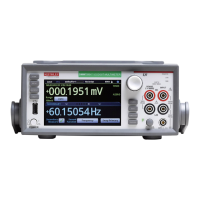7½ Digit Graphical Sampling Multimeter Reference Manual Section 2:
DMM7510-901-01 Rev. B / May 2015 2-65
Comparison of the communications interfaces
The following topics discuss some of the advantages and disadvantages of the communications
interfaces that are available for the Model DMM7510.
Simplicity
The GPIB interface is the simplest configuration. Connections are simple, and the only necessary
software configuration is setting the instrument address.
An ethernet network is a simple configuration if you can use the automatic settings. It is more
complicated if you need to set it up manually. If you must set up your ethernet network manually, you
need some knowledge of networking. In addition, your corporate information technology (IT)
department may have restrictions that prevent using an ethernet network.
A USB interface is also simple to set up. However, it requires an instrument-specific device driver to
communicate with the instrument. This can limit the operating systems that are available for use with
the instrument.
Triggering
The GPIB interface provides the fastest, most consistent triggering. It has the lowest trigger latency of
the available communications types. Trigger latency is the time that it takes the trigger to go from the
computer to the instrument. GPIB also allows you to send triggers to multiple instruments
simultaneously.
If you use a USB interface, it is difficult to synchronize triggers that are sent to multiple instruments.
For applications that require synchronized triggering, you must use digital I/O. The trigger latency with
a USB interface is higher than latency with a GPIB interface, but it is lower and more consistent than
latency with an ethernet interface.
Transfer rate
Of the available interfaces, USB has the fastest transfer rate, followed by the ethernet and GPIB
interfaces. The GPIB interface, however, offers the most consistent transfer rate.
Instrument naming
Names for instruments that are named through NI-VISA
TM
are in a human-readable format. USB
instrument names are not intended to be human-readable.
Distance and instrument limitations
For GPIB and USB interfaces, the cabling distances between the controller and instrument or hub are
limited to 30 feet. In a system connected with GPIB or USB, you can have up to 15 instruments
attached to each controller.
The distances for ethernet interfaces are unlimited if the ethernet address of the instrument and ports
for the various services it uses are visible publicly (for example, port 80 for web service). If you are
using an ethernet interface, you can communicate with an instrument anywhere in the world. In a
system that is connected through ethernet, the number of instruments you can attach to each
controller is only limited by the controller and the connections available on that controller.

